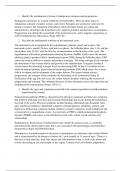1. Identify the mechanisms of action of endogenous estrogens and progesterone. Endogenous hormones are created within the cell (internally). There are three types of endogenous estrogen: estradiol, es trone, and estriol . Estrogens are secreted in various levels during a woman’s life, beginning with puberty which develops female sex organs and characteristics, encourages the menstrual cycle, supports gestation and decreases in menopause. Progesterone acts during the second ha lf of the menstrual cycle, and it supports a pregnancy as well if fertilization has taken place. (Pa ge 109 -110) 2. Describe the fundamental workings of the menstrual cycle. The menstrual cycle is regulated by the hypothalamus, pituitary gland, and ovaries . The menstrual cycle is usually 28 days, split into two phases - the follicular phase (day 1 -14) and the luteal phase ( day 14 -28)- with the first day of menstruation as the first day of the cycle. The hypothalamus will release gonadotropin -releasing hormone (GnRH) which causes the anterior pituitary gland to produce follicle stimulating hormone (FSH) during the follicular phase. FSH causes the ovarian follicles to mature and produce estrogens. The rising estrogen levels continue the maturation of the ovaria n follicle and growth in the endometrium. A negative feedback system senses the increasing estrogen levels by decreasing FSH. At day 14 ovulation occurs when the anterior pituitary gland releases luteinizing hormone (LH) which causes the ovarian follicle to rupture and development of the corpus luteum. The corpus luteum releases progesterone and estrogen which continues the thickening of the endometrial lining. If fertilization of the egg does not occur, the corpus luteum atr ophies reducing the secretion of progesterone and estrogen. The continued decrease of these hormones causes the regression and shedding of the endometrium. (Pages 110 -111) 3. Identify the signs and symptoms associated with common reproductive health problems experienced by women. Premenstrual syndrome (PMS) is characterized by physical, emotional and beha vior symptoms that interfere with daily activities and personal relationships that occurs during the luteal phase (last half of the cycle) . Physical symptoms include bloating , abdominal pain, headache, back pain, and breast tenderness. Emotional symptoms include agitation, irritability, anxiety, and depression . Behavioral symptoms include outbursts of anger, confusion, social w ithdrawal and oversensitivity to insignificant events. A severe form of PMS is called premenstrual dysphoric disorder (PMDD) and causes severe interference with work, school, social activities and relationships. Endometriosis, the presence of endometrial tissue outside the uterine cavity, is commonly characterized by chronic pelvic pain, but is also associated with menorrhagia, dysmenorrhea, dyspareunia, fat igue and abdominal pain. Menopause is a normal response to decreases in endogenous sex hormones and ovarian follicles and is characterized by the absence of meses for 1 year (usually at 51 years of age). There is a decrease in skin elasticity, body hair, breast and subcutaneous tissue, as well as the uterus and ovaries decreasing in size and atrophy of the vagina. Urinary issues, hot flashes, palpitations, headaches, dizziness, insomnia, irritability, anxiety and depression are common with menopause as well. (Page 111) 4. Identify the prototype drug for the estrogens, progestins, and estrogen -progestin combinations. Conjugated Estrogen (Premarin) is the prototype estrogen. (Page 112) Medroxy -progesterone acetate (Provera) is the prototype progestin, which is a synthetic progestin and progesterone derivative. (Page 116) The prototype for hormonal combination is ethinyl estradiol -norethindrone (Ortho -Novum) and for hormone replacement therapy the prototype is conjugated estrogen -medroxyprogesterone (Prempro ) (Page 120) 5. Describe the estrogens in terms of action, use, contraindications, adverse effects, and nursing implications. Action: Estrogens inhibit hypothalamic secretions of GnRH, and then inhibit secretions of FSH and LH from the pituitary gland. When these hormones are not secreted, ovulation cannot occur. They also increase ce rvical mucous to prevent the spermatozoa from reaching the upper reproductive tract. Additionally, they interfere with the maturation of the endometrium. These reactions occur as estr ogens are circulated in the bloodstream to target cells. Upon entering the cells they combine with receptor proteins an d this complex interacts with the CNA in the cell nucleus to produce RNA and new DNA that stimulates cell reproduction and production of certain proteins. (Page 11 2) Use: In birth control pills as contraceptive preparations to control fertility, emergency contraception, treatment of menstrual disorders. Used to relieve symptoms of estrogen deficiency in menopausal women. As replacement therapy when there is an estrogen deficiency resulting from hypofunction of the pituitary gland or ovaries which can occur anytime in the life cycle. (Pages 112 -113) Contraindications: known or suspected pregnancy, thromboembolic disorders, known or suspected cancers of breast or genital tissue s, undiagnosed vaginal or uterine bleeding, fibroid tumors of uterus, active liver disease , history of cerebrovascular disease, coronary artery disease, thrombophlebitis, hypertension, or conditions predisposing of these diseases, tobacco use, and family history of breast or reproductive sy stem cancer. (Page 115) Adverse effects: Increased risk of thromboembolic conditions, menstrual disorders, GI upset, gallbladder disease, central nervous system adverse reactions can be caused or aggravated, edema and weight gain, and cancer. (Pages 114 -115) Nursing implications: First, you must gather an extensive medical, social and family history to rule out any possible contraindications as well as gather height, weight, and vital signs at the time of screening. It is important to educate the patient on possible drug interactio ns as e strogens




